DACS(Detection on Attacking Control System)
Overview
Cyber threats are increasing rapidly but there are problems in applying general purpose security system to control systems of national infrastructure industries such as nuclear industry due to the characteristics of their control system, components, and vendor-subordinate communication protocol.
DACS is control network particular or control-level multi filter-based embedded security system which is specialized in industry control system. It minimize cyber threats and their potential damages to national infrastructure.
Design features
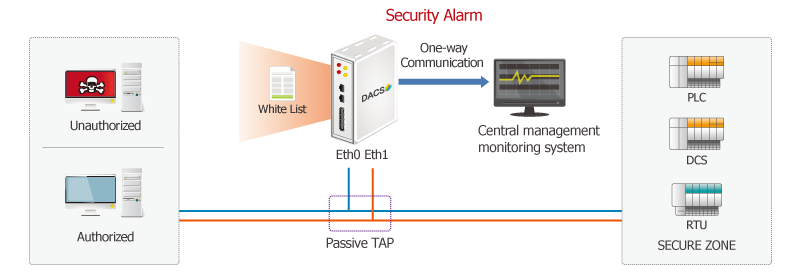
- DACS was developed to minimize the damage of cyber threat to industrial control system applied to national infrastructure(nuclear power, electric power, oil, gas, chemical plants and etc.).
- DACS is a multi-filter-based embedded security system based on control network detail field or controller level specialized in industrial control system.
- Because the design of DACS system is based on network tapping, there is no impact on the communication lines due to system error or power outage.
- DACS enhances security with embedded RTOS(Real Time Operating System) design
- DACS is designed to carry out detection only without blocking network packet
- White list-based Security Solution
- Certified by Nuclear Equipment Qualification design
Simulator Composition
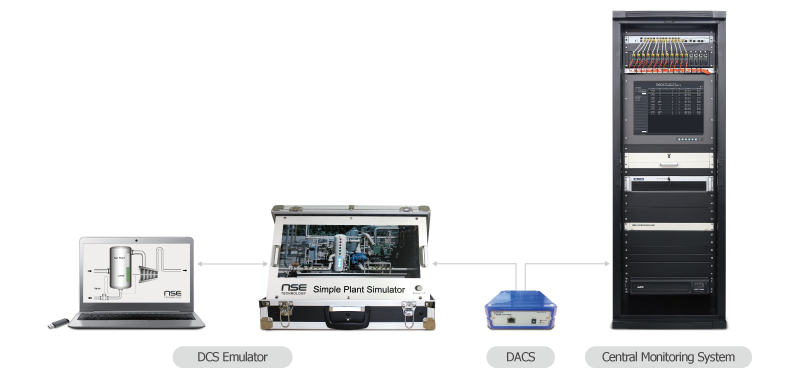
- DACS function
- Packet filter based intrusion detection function and Modbus filter (industrial protocol) based intrusion detection function.
- Monitoring System
- A central management alarm system that collects and displays on-screen all detection information connected to DACS. If any abnormal access occurs, the monitoring system sets off alarms for the operator to confirm the detection in real time.
System Architecture
- Nuclear protocol-based penetration detection system
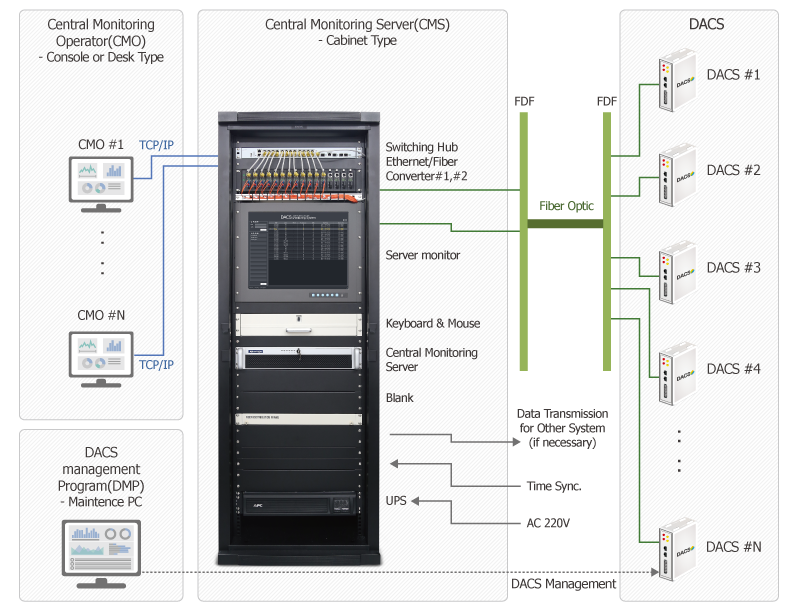
- White List-based Security Solution
- According to cyber attack acceleration aiming weakness of industry control system, DACS applies White List-based security method instead of Black List-based method in order to strengthen safety.

Composition
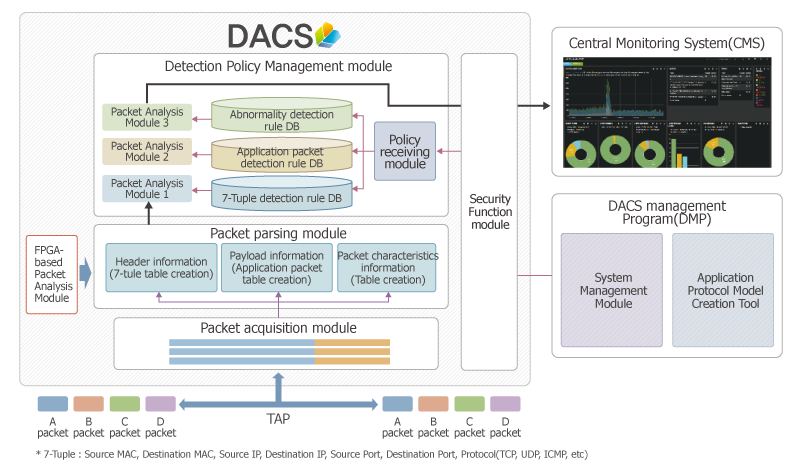
- Consists of packet collection module for collecting communication packets, packet parsing module for classifying packets according to types, and detection rule management software for detecting the anomalies.
- Application protocol model creation tool: Provides a tool for users to directly create detection rules for protocols that cannot be divulged to public.
- Detection system management software: Sets application layer protocol model, DACS rule change, configuration and etc.
- Monitoring System: Provides a monitoring viewer, and supports the security manager to recognize the current security status by collecting DACS detection information, analyzing the result, and writing event logs.
- Uni-directional Transmitter: Transmits signals in uni-direction, and performs physical blocking and electrical isolation to prevent propagation of abnormal signals in the reverse direction.
features
- DACS is a product that provides prevention and detection function from cyber infringements that can occur in nuclear power plant. It will be developed to meet the safety and security regulation standard of nuclear facility.
- Provides security alarm and management function following the detection of cyber infringements of IPS (Information Processing System) and non-safety system network of digital instrument and control system in nuclear power plant.
- The uni-directional transmitter will be developed as a product that satisfies the regulatory requirements of the domestic nuclear power plant's cyber security in the digital instrument and control system.
- The uni-directional transmitter will be miniaturized for installation in the existing system and the acquisition of nuclear safety grade (Q-Class) is planned for the transmitter.
Intellectual Property
- A PLC device with enhanced cyber security (Patent No. 10-1572854)
- A PLC device provided with a function for managing quality (Patent No. 10-1539253)
Quality Certification
- KEPIC-EN Certification Acquired - Manufacture of Electricity 1st Grade(Control, Alarm, Surveillance), Instrument & Control Device(Cyber Intrusion Detection System and other one)
SDD (Safety class Data Diode)
Overview
SDD is an Optical Converter that is installed in the optical isolation section of the control system network to block abnormal signals from being reverse propagated and transmit signals by uni-direction.
- Simple, UTP and Fiber Connections
- One-way Data Transmission
- Reverse Signal Physical Block
- Electrical Isolation
- Model No.
- SDD-T : Transmit (Tx) Only
- SDD-R : Receive (Rx) Only

Product Specification
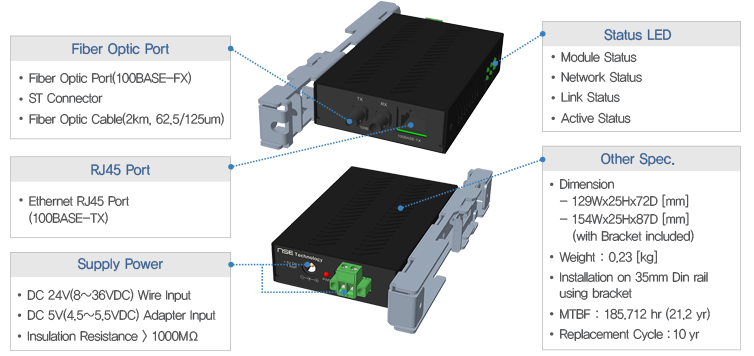
System Features
- Optical converter that blocks abnormal signals from reverse propagation and transmits signals by uni-direction.
- Satisfying safety and cyber security regulation for Nuclear Power Plants.
- Certified by Nuclear Grade Equipment Qualification(Environmental, Seismic, EMC).
System Application
- Performs boundary by installing in the optical isolation of the safety system and non-safety system.
- SDD-T performs only one-way transmission and SDD-R performs only one-way reception to provide safe and highly secure one-way transmission function.
- Possible to install in the cabinet of the existing instrumentation and control system by miniaturizing the hardware.
CySEAL(Cyber Security Evaluation And Lifecycle)
Overview
A nuclear power plant licensee must establish, implement, and maintain a cyber security program that protects any digital system, network, or communication system by 10 CFR 73.54(b)(2) and 10 CFR 73.55(b)(8). Acceptable method is required for establishing, implementing, and maintaining a cyber security program to comply with the regulations. CySEAL is management tool for these.
Lifecycle of Evaluation
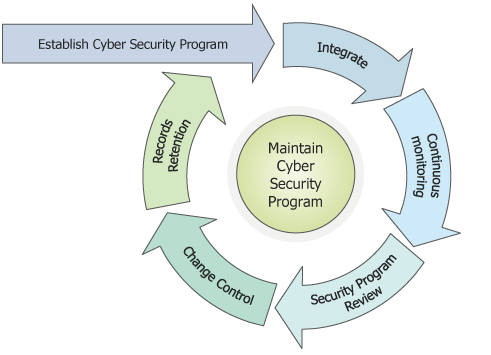
- CySEAL is a tool for evaluating and managing the critical system (CS) and critical digital asset (CDA) of the digital instrument and control system according to regulatory requirements during the nuclear power plant lifecycle.
Composition
- Evaluation module : Drawing Edit for evaluation target system, evaluation according to requirements.
- Evaluation management module : Evaluation management for digital system in conjunction with CM system
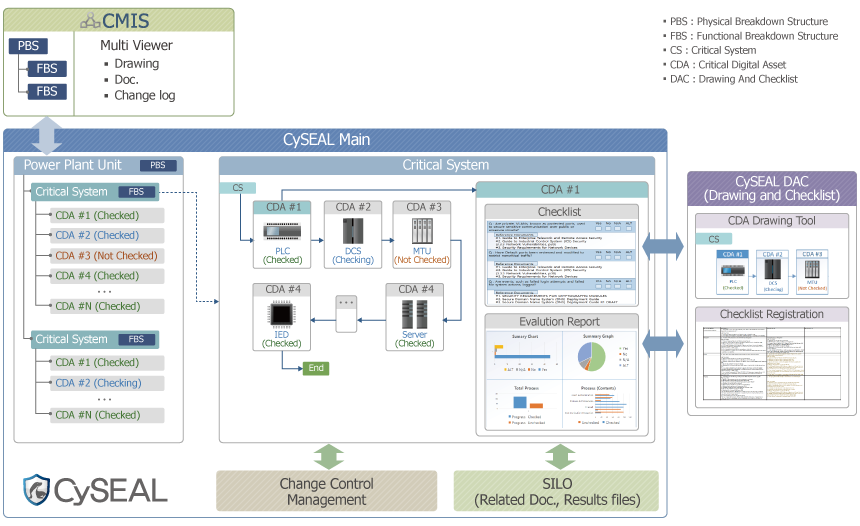
H/W & S/W Design
Introduction
NSE Technology has been accumulating various licensing experiences and technologies about safety evaluation and I&C design in the fields of Nuclear Power Instrument & Control. NSE Technology has hardware and software design capabilities Including PCB board design related to I&C system, communication system, safety management system and automation system. Especially, including cyber security evaluation, embedded system's CPLD/FPGA design and verification tasks, NSE Technology has rich experiences in designing position controlling unit development for PLC, D/A transition unit, A/D transition, Embedded System design and OS porting technology(Linux, WinCE). NSE Technology is putting utmost efforts to developing technologies that can secure reliabilities of hardware and software.
[Safety Evaluation Instrument & Control System]
Overview
- Safety evaluation of digital I&C system
- Cyber security evaluation of digital I&C system
- CPLD/FPGA design and verification of digital I&C system
- Safety evaluation of Real Time Operating System(RTOS)
- Risk evaluation of digital instrumentation and control system
- Safety evaluation of human engineering
- Safety evaluation of MCR design
- Evaluation of human reliability
- Integrity evaluation of H/W & S/W
V&V of Digital Instrument & Control System
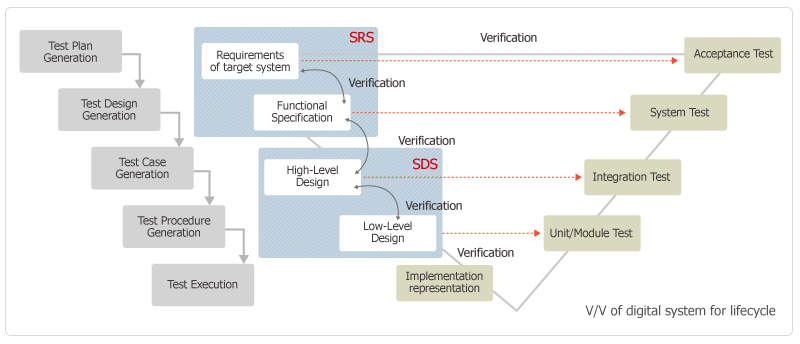
[CPLD/FPGA Design and V&V]
Overview
- Integrity analysis of CPLD/FPGA design and design change through compatibility analysis and simulation.

Far Field Test of PCB Equipped with CPLD/FPGA
- Build of Test Bed Environment, Board Level Input/output Signal Reception, Received Signal Analysis and V&V
- Creation of Test bench from Received Signal-Line's Wave Form
- Making Judgment of Design Compatibility through Comparative Analysis with Timing Simulation's Results


